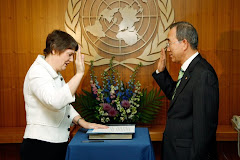To read story on Trinidad express click here
Aabida Allaham
EVEN with a decline in adolescent fertility across the Caribbean, early parenting continues at worrying levels.
Hernando Agudelo, acting deputy director at the United Nations Family Planning Association (UNFPA) sub-regional office for the Caribbean, said nearly 20 per cent of the live births in the region are to an adolescent mother.
’A few decades ago in the Caribbean, total fertility rates (TFR) were among the highest in the world. Today, the average number of births per woman is below the replacement rate,’ he said.
Agudelo, who was addressing parliamentary delegates at the opening session of the Caribbean Network of Parliamentarians on Population and Development at the Hilton Trinidad last Friday, added that several countries in the Caribbean are only having enough children to replace their ageing population.
Several countries in the Eastern Caribbean are slowly reaching targeted levels. But in Grenada and St Vincent and the Grenadines, the average number of births per woman is still below the average replacement rate.
’The majority of the Caribbean countries are among the 50 more dense populated countries in the world, even above China which has 137 for every square kilometre. Barbados has 595, Jamaica and Trinidad are both at 256 and St Lucia is at 319,’ he said.
Meanwhile, the evidence shows that there are high levels of unwanted pregnancies, mainly among the underprivileged, and Agudelo believes this is directly related to poor family planning.
The persistence of factors limiting the exercise of their reproductive rights, access to reproductive health among the adolescent and youth population is also of particular concern to him.
’The UNFPA believes that the greatest health inequity in the world is maternal mortality. Every minute another woman dies in less developed nations and this reinforces inequality and poverty. In the Caribbean the evidence indicates that overall levels of maternal mortality remain relatively low with only two countries with rates above 100 per 100,000 but ratios have shown no significant decrease over the last decades,’ he said.
While delivering the feature address, Health Minister Jerry Narace said they were aware of the challenges that continue to exist in the Caribbean region, particularly in terms of the integration of the different health services used by pregnant women.
















































No comments:
Post a Comment